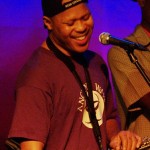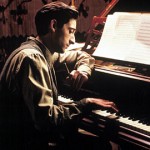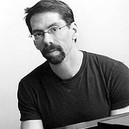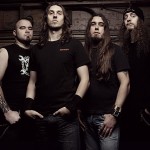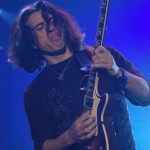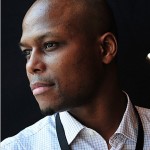In the summer of 1994 my girlfriend and I went to see Metallica at Wolf Mountain, a ski resort-cum-concert venue near Park City, Utah. The Suicidal Tendencies were on the bill as well, along with overnight grunge superstars Candlebox; our plan was to catch the former and miss the latter. Would that we had read the tea leaves, or at least looked at Billboard, because we ended up doing the reverse—missing the venerable Tendencies, that is, and suffering through a Candlebox set that slouched its livelong way to the one-hit vanishing point “You.”
I was still smarting from being denied the “How Will I Laugh Tomorrow” pit—there’s nothing like an outdoor mosh pit on a hot summer day—when Metallica came on a little after dusk. By the time the sound of machine gun fire rippled over the PA, signaling the beginning of the Johnny Got His Gun-inspired ballad/suite “One,” it was full dark. The lighters came out, the crowd held its breath. Then, high up on a riser, James Hetfield appeared and played the opening minor arpeggio: ding-ding-ding-dang. A collective exhale.
Well … “appeared” isn’t quite the right word. He sort of swung around like he was mounting an invisible horse, assumed a cock-legged pose, backlit and frozen. And my girlfriend and I, we just burst out laughing. How could we help it? That pose—it didn’t signify Metallica anymore, or even metal; it signified rock star. Mind you, at that point I was still going to the mat for the so-called Black Album, and if you give me more than thirty seconds I’ll regale you with what I believe to be that album’s many merits. But this? Load, Some Kind of Monster, “Nothing Else Matters” with strings—in that moment, I saw it all, the whole ugly coast into ignominy.
Could we have been the only ones who laughed? I doubt it. Maybe the crowd roared with laughter.
Almost twenty years later, I’ve stopped blaming Metallica. I’m blaming Anthrax instead. That’s right—Anthrax! I blame Anthrax. Why, you ask, would I blame such a fun-loving bunch of guys, the band that epitomized the warm-and-fuzzy machismo of thrash metal in its heyday? A willful contentiousness? Partly, yes. But you see, I fell out with Anthrax back in ‘88, years before Metallica’s apostasy, at the very noon of thrash’s day. In hindsight, I think my quarrel with Anthrax—a premature quarrel, I admit, but a quarrel nonetheless—sheds more light on thrash’s then-incipient demise than the oft-cited narrative of Metallica’s starstruck fall on the one hand, and the rise of grunge, hip hop, and other heavy alternatives on the other. But don’t despair: my counternarrative has a happy ending. It’s called Worship Music, and it’s really what brought me to want to write something about Anthrax in the first place.
*
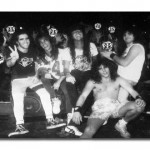 1987 was a banner year for Anthrax. It was the year of their seminal Among the Living, the band’s second album with singer Joey Belladonna, their third overall, and the gold-selling metal-rap crossover “I’m the Man.” With Living, Anthrax’s sound had crystallized into something immediately recognizable: “buzzsaw” guitars, furiously-pedaled double bass licks, groovy mosh parts, and catchy, melodic choruses. The lyrics, which Belladonna delivered with a mix of opera aria and Bronx sneer, were as likely to adapt Stephen King as to address social issues—“Star Wars,” racism, drugs. And yet, despite their penchant for horror and social commentary, Anthrax were a good deal less bleak than their thrash counterparts. You could hear it in those chipper choruses, so unusual for the genre, and in the words that tended to look past problems, to solutions: flags of many colors, fighting for peace.
1987 was a banner year for Anthrax. It was the year of their seminal Among the Living, the band’s second album with singer Joey Belladonna, their third overall, and the gold-selling metal-rap crossover “I’m the Man.” With Living, Anthrax’s sound had crystallized into something immediately recognizable: “buzzsaw” guitars, furiously-pedaled double bass licks, groovy mosh parts, and catchy, melodic choruses. The lyrics, which Belladonna delivered with a mix of opera aria and Bronx sneer, were as likely to adapt Stephen King as to address social issues—“Star Wars,” racism, drugs. And yet, despite their penchant for horror and social commentary, Anthrax were a good deal less bleak than their thrash counterparts. You could hear it in those chipper choruses, so unusual for the genre, and in the words that tended to look past problems, to solutions: flags of many colors, fighting for peace.
“Imitation of Life,” the last song on Living, is a genre-appropriate paean to authenticity, a great “be yourself” underground anthem against the “plastic” world of media-driven image-making that Anthrax was likely just beginning to encounter. The chorus is indicative of the tenor of the song: “There’s nothing I hate more than all these plastic people/ With all their plastic promises, and all their plastic deals/ They just can’t be themselves, and live their own lives out/ They’re just an imitation of what life’s all about.” Once it revs up, “Life” is easily the fastest cut on the album, as if the breakneck tempo were necessary to assure both band and listener of each other’s authenticity, their underground pedigree.
If you can see past the homophobia*—I won’t blame you if you can’t, but I’m going to—one verse is a nutshell response to the more lucrative, radio-friendly glam or “hair” metal that dominated the charts during the same era: “Bands dress like women, with hairspray and lace/ I’d pass an image law, stick it in their face/ Let’s see how long they keep dressing this way/ Wearing their image twenty-four hours a day.” Image versus reality; pop versus underground; poseurs versus “true metal.” One can’t help but wonder whether these lines are directed at the “friend” mentioned in the first verse: “Whatever happened to the guy I knew?/ A media creation, a monster grew.”
Now, replace “guy” with “band,” and by 1988 you could have asked Anthrax the same question.
“Monster” is maybe too strong a word, but “media creation” nonetheless … and one that the band, the whole scene, participated in creating: instead of “hairspray and lace,” high-top sneakers, jock socks, baseball jerseys or concert T’s, Bermuda shorts or cut-off jeans.** And here’s the really insidious part: the band that wears hairspray and lace might, if they so choose, remove it after a performance. But by ‘88, I have the impression that Anthrax was wearing their image 24 hours a day, trapped in the mirror they held up to themselves, and to the scene. Anthrax, that is, became “Anthrax,” a parody of themselves, an image they fell in love with and, like Narcissus, died trying to embrace (well … almost).
Is that your fist I hear, beating on the computer screen? You’re saying, They didn’t sell out. Metallica did—put on the eyeshadow and the furry vests, grew the Beatnik goatees and started listening to indie rock, went all Billboard on our asses. Anthrax always dressed that way. Yes, yes, all true … but isn’t this precisely how it happened? Anthrax were so preoccupied with authenticity—with the idea of thrash (“true”) metal being no-image music, and the scene a big family—that as they achieved greater success, they had no choice but to create an image of authenticity to project for their fans.
Look at the photo on the sleeve of 1988’s State of Euphoria: the band members shine like wax effigies of themselves, cutouts against a postcard New York. Quite a switch from the leather-clad Anthrax in the 34th Street subway station on the back of Living: from the underground to the top of the world. But it’s not the backdrop that really matters here, or the clothes. As for the music, what’s notable about Euphoria is not how different it sounds from Living—the sort of about-face we would expect from a “sell-out”—but how similar. It sounds, properly enough, like the zombie- or pod-version of Living (as in the pod people from Invasion of the Body Snatchers).
I’m pinning a year on it, but in hindsight it’s clear the tendency was there all along: the progressive ossification of their sound between ‘85’s Spreading the Disease and Euphoria; the line-drawn caricatures of the band on the sleeve of Disease; the proliferation of their little Mario Bros.-style mascot; the increasingly tedious use of “mosh” and “not,” which by ‘87 had begun to creep their way into titles, choruses, and verses. This is how it happens: Anthrax lingo, Anthrax gear, Anthrax themes. The music becomes the logo, the image grows legs; the songwriting gets stilted, the lyrics predictable. At the time, though, it seemed to happen almost overnight, a crash landing off the peak of Living into the stale slough of Euphoria. (“His meridian is at once the darkening and evening of his day,” says the Judge about the human species in Cormac McCarthy’s Blood Meridian. Would that Anthrax had put down the King for a while and picked up McCarthy. Not that I dislike Stephen King, but I’m still waiting for the metal band that will tackle Blood Meridian with the combination of aplomb and naïve faith Mastodon did Moby-Dick.)
You’ll say I’m not giving them enough credit. There’s not a metal band with a better sense of humor, or one more adept at self-parody, and this should imply a certain level of consciousness about image-making: the tongue-in-cheek side project S.O.D. (Stormtroopers of Death), with their LP Speak English or Die; the tracksuit-and-Anthrax-bling cover photo on the puerile but well-intentioned “I’m the Man.” And yet, like the very “un-thrash” upbeat optimism of much of the music, humor was just part of who they were—part, that is, of the fun-loving bunch of down-to-earth Bronxites that coalesced into the master-image “Anthrax.”
In fact, it’s hard to think of a band that better embodied the goofy camaraderie of the scene: punk with the edges sanded off; a sort of feel-good hardcore, if such a thing is possible. Maybe this is why it was so easy for them to become an image not just of themselves, but of the scene. After Anthrax became “Anthrax,” it wasn’t long before thrash became “thrash.” Images live forever, but the scenes (and bands) that produce them, like the hapless characters in Adolfo Bioy Casares’s La invención de Morel, rot to death.
I have the feeling that if any devout thrasher were going to blame Anthrax for killing the scene, it would be for a reason opposite the one I’m arguing. Anthrax were one of the few bands—thrash metal so incestuously devoted to maintaining the bulwark of its authenticity against the dreaded pop Other—audacious enough to reach outside the genre for inspiration: into rap (“I’m the Man,” and later the cover of Public Enemy’s “Bring the Noise”) and British pop (Joe Jackson’s “Got the Time”).*** Anthrax, my imaginary devotee might argue, were too open to rival musics, so that, even as they remained one of the lead proponents of genre, they were simultaneously breaking down the very musical barriers that defined it. They let the wrong ones in. (It should be noted that this openness to musical innovation was of a piece with their politics—a schmaltzy one-world liberalism they espoused when they weren’t singing about Judge Dredd, Randall Flagg, or poseurs. The band’s anti-racist tracks on 1990’s Persistence of Time could be read as responses to thrash’s genre jingoism.)
I don’t disagree with this argument, just with the sentiment that often accompanies it (i.e., “letting the wrong ones in”). I think the scene needed to die. The music needed to move on; the death-in-life of Euphoria needed to be transcended. I think that if you did a survey of metal albums in 1988, you’d find a lot of bands either stalling out or beginning to move in new directions. Anyway, that Metallica did what they did, as they did it, is hardly Anthrax’s fault; they just happened to arrive first, or maybe just most transparently, at that combination of ossification and innovation that happens in all scenes once they begin to become successful. Anthrax had to kill the scene in order to escape it; Anthrax had to help create the ‘90s in order to escape themselves.
There are some fine moments on Euphoria, of course, and even more on 1990’s Time, an album that was just beginning to break free of what had become Anthrax clichés (e.g., “Misery Loves Company” and “Who Cares Wins”), in part by digging in a more organic way into hip hop (listen to “Blood” and “Discharge”), helping forge a style that would explode as groove metal. By 1993, everything had changed: music had moved on; Sound of White Noise, with new frontman John Bush has little in it to identify the old Anthrax; it sounds more like Alice in Chains. The album would turn out to be their last hurrah, and the fact that it went gold probably allowed Anthrax to store up their proverbial acorns for the long, bitter winter to come. For the next eighteen years would be a limbo of delayed and squelched releases, remixes, remasters, reunions, best-ofs, rotating singers and lead guitarists, and guest appearances—a time, for all but the most observant and least jaded, of white noise and silence.
*
Before Worship Music finally arrived in record stores (metaphorically speaking) last September, turning the hometown tour-ending “Big Four” show at Yankee Stadium into a giant release party, Anthrax were probably the only of the better-known thrash bands that hadn’t yet put out a new album. Not for want of trying—I won’t go into the reasons for all the delays—or for lack of new material. Or, for that matter, for lack of energy: they had already been on the road with the Big 4 for a year, and were about to jump into another tour, supporting the new album, with Testament and Death Angel sharing the bill. But then a band with a day named after them (last year, Borough President Ruben Diaz, Jr. declared September 14th “Anthrax Day in the Bronx”) has certain responsibilities—ribbon cuttings, ship christenings, and relentless touring being just a few of them.
The tour wrapped up early last month at Times Square’s Best Buy Theater—the Venue Formerly Known As Nokia, and before that, something else; its “original” name, if it ever had one, has been buried under the rubble of a thousand brands. Part celebration, part history lesson, part nostalgia trip, the Best Buy show presented a perfect opportunity to gauge the health of a music enjoying a sort of second teen-hood … or, perhaps, suffering a mid-life crisis.
The Best Buy crowd was the typical mix of geriatric metal fans from the ‘80s and high school- and college-aged kids, and the bands’ song selections tended to mirror that generation gap, straddling old and new material and mostly ignoring anything in between. Death Angel’s set was an extreme example: they only played stuff off their debut The Ultraviolence and the new record, Relentless Retribution. It reflects both the arc of their career—at this point, DA’s revival has lasted twice as long as their first run, and has been equally prolific—and, I guess, the limitations of a thirty-minute set. Testament’s choices were a bit more varied, albeit very much first-songs-and-title-tracks fare. There were a few pleasant surprises—opening the set with “The Preacher” (from 1988’s The New Order) was a nice touch, and I was happy to see them still pushing full-throttle renditions of “D.N.R. (Do Not Resuscitate)” and “Three Days in Darkness” from their middle-years masterpiece The Gathering (1998).
While all the bands were clearly old hands at playing on the expectations of a mixed-age audience, Anthrax had it down to a science. “How many of you here are seeing Anthrax for the first time?” (Cheer!) “How many of you crazy fuckers have seen us before?” (ROAR!!!) You know, that sort of thing. They certainly hit the peaks of their early career, spending the most time on the Everest of Living, and ignoring the ‘90s completely (if there was a token song from White Noise, I missed it). Somehow, the fact that they only played the covers off Euphoria and Time—regardless of the fact that these were singles—felt like an even bigger post-‘87 smackdown. No “In My World”? No “Now It’s Dark”?
All of the above suggests that the Worship Music tour was something of a continuation of the Big 4: after all, Testament and Death Angel are children of 1987, both born at the watershed moment the Big 4 was meant to commemorate. And yet, the fact that both these bands chose to close their sets with new material should not be lost on us—or on Anthrax, who went for the old, safe standbys “I’m the Man,” “Madhouse,” and “I Am the Law.”‡ I know they’re the quintessential NYC metal band—the blue-and-white jerseys, Joey’s Yankees cap pulled low on his head, Frankie and Charlie playing their first (and last) show after attending somebody’s grandmother’s funeral. This is metal concert as sporting event: you come to root for Anthrax like they’re the home team, and they give back that tough New York love (and buckets of popcorn nostalgia). But then I think of Testament playing “D.N.R.” Maybe that should be the injunction to all these comeback bands: We love to hear your old shit, sure. But 1987 is dead and gone, never to be revived. What have you done lately?
For what else can you say to a band that releases one of the finest metal albums of the last who-knows-how-many years, and then only plays four songs off it live—the same number they played off Living? Not that the choices weren’t good: the opener “Earth Is On Hell,” the pump-you-up zombie-killing anthem “Fight ‘Em Til You Can’t,” the Dio-worthy “Devil You Know,” and the metal mass “In the End.” But with an hour and a half to burn, I expected at least a couple more. There’s more than enough depth on the record to warrant it. Proportionally, Anthrax played less new material than either of their warm-ups, and Testament wasn’t even pushing a new album. Even before their set had ended, the shadow of the Big 4 growing ever longer, I started to wonder whether the band fully understood what a gem they had in Worship Music: not so much an album as an exercise in imitative magic, perhaps the only thing capable of breaking the thrall of the image of 1987 that threatens to pull the genre back under.
*
Death Angel’s frontman Mark Osegueda has always struck me as a bit of a prophet. He has the godlike ability to go from a growl to a shriek and back to a growl again in a breath, a hyperpitch jump across five octaves. (Eat your heart out, Captain Beefheart!) And the things the man says. No matter how tough you think you are, you’re never too tough to let yourself go. Yes. Despite his claims to have never quite fit thrash’s vibe—a little too flamboyant, a little too interested in Tom Waits and The Velvet Underground—I think his combination of waist-length dreads and tight black jeans/leather vest for the Best Buy show beautifully articulated the divided ethos of the Bay Area scene: part ganja-smoking hippie, part brassknuckled Hell’s Angel. Anyway, he didn’t let his reservations get in the way of being the genre’s oracle that night, with a pronouncement that disciples like myself would spend the next hour pondering for ever-deeper layers of meaning: We’re Death Angel from San Francisco, and we play thrash metal.
Inspirational, no? Rather sums the whole thing up. Very much the sound of the new Death Angel, too. In fact, the new Death Angel sounds more like they did in ’87 than in ’90, when, like Anthrax, they had begun to chafe at the boundaries of the genre. (The result was their masterpiece, Act III; there never was a IV or V.) The stuff they played live, at least—that endless gritty chugga-chugga-chugga on the low E string—suggests they have made it their mission to epitomize the genre-as-it-was.
This desire to thaw the frozen image of 1987 and breathe life into it, or at least nuke it, is sadly typical. The back-to-back nostalgia tours and reunion with Belladonna would suggest that Anthrax, too, have embraced the revivalist spirit. But Worship Music suggests something different, or at least something more vital and interesting. For even as that record looks backwards, reaching all the way down into the choral-melodic elements of the band’s power metal roots and the heavy riffage of their thrash metal coming-of-age, it manages to draw these sounds together with ‘90s grunge into an impressively syncretic whole. It is free of the late-‘80s clichés that hamstrung so much of Euphoria, and to a lesser extent, Time—yet it is still recognizably, inimitably Anthrax. In looking back neither from a desire to “relive” the ‘80s, nor to show they have “outgrown” the ‘80s—to cheapen it with an ironic sneer—but rather to work with and attempt to reinvigorate that musical tradition, Worship Music evinces a rare maturity of vision. This isn’t maturity in the sense that people said Anthrax “matured” after Euphoria—the meaner, darker Anthrax of Time and White Noise. They’re as full of humor and hope as they ever were, and as melodic, too—even moreso.
In some ways, the album seems to want to be heard as what the band would have put out after Persistence of Time had Belladonna stuck around. The ticking clock on the breaks in “Earth is on Hell” recalls the opening of Time; the solo cello of “Hymn 1,” which is really the introduction to “In the End,” is an instrumental quote from “Be All End All” on Euphoria. But in a transformation that is characteristic of the new record, following “End”’s break for chimes, as Belladonna comes back in to chant the hymn, he is accompanied by the guitars, which, buzzing with sustain and sweeping up and down the low strings, themselves sound bowed. Rather than a follow-up, then, Worship Music sounds like it’s having a conversation with the Anthrax of 1988-90 … but a conversation that could only be had at two decades’ distance.
As I noted earlier, Anthrax’s music was always more cantabile than that of their riff-centric comrades, and on Worship Music this element of their songwriting definitely comes into its own. Call it glee metal: upbeat, chorus-driven, effortlessly melodic. I can’t think of a metal band that writes choruses like this anymore, and it’s not like nobody’s trying: all those dreadful emo-death bands put a lot of stock in melodic choruses, the obligatory counterpart the growled verses. These desperate attempts to sound both heavy and emotional … as if they were mutually exclusive! I sound mean, but I’m really just hurt. Ugh. Anthrax could teach these bands a thing or two, and not just about attitude (metal! no wallowing!), but about composition: the call-and-response formats, the clear melodic climaxes, the canny uses of repetition in rhythm and phrasing.
I could go on about the unreasonably good songwriting here—pretty much everything on Worship Music is lean and harmonically seamless—but I’d rather focus for a moment on the use of breaks, of silence, to create a sense of space—always a gamble in a style of music defined by relentless noise. “The Devil You Know” is the most obvious in this respect: the two-measure-long riff is followed by two measures of silence, as if the band had stopped to listen to their own echo. With each break the sense of expectation grows; the breaks changes the way we hear the verse when the spaces have been filled and the song settles into a groove. This use of silence in the intro is mirrored later by the way the riff disappears at the choruses, then edges its way in at the ends of the choruses, and then finally overwhelms them, before a coda of (almost) fully-silent breaks in the “false endings” outro. “Devil” isn’t the only song that uses silence to build and release tension and to create space and contrast. There are well-placed (if briefer) pauses before the choruses of “Fight ‘Em,” dividing the pre-chorus football-squad riot vocals from the rise-up singalong that follows; the bridges of “Earth is on Hell,” “I’m Alive,” and “In the End” use pauses and silence to similar effect. I wonder if it’s this sense of space that allows Charlie Benante, always ranked among the genre’s top drummers, to shine even more than usual, from the opening blast-beat of “Earth is on Hell,” through the tight, straightahead groove of “Devil,” all the way to the brick-throwing storm at the end of “Revolution Screams.”
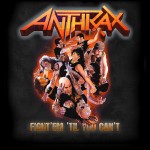 Which brings me, somehow, to “Fight ‘Em Til You Can’t.” It’s not just the soundtrack for a zombie movie-to-be (a few people have already made zombie-killing videos for the song; rhythm guitarist and founding member Scott Ian has posted one of them on his Facebook page). It’s also the Rocky theme of the band’s comeback … though the title’s reference to defeat suggests, once again, a more mature perspective. On the CD gatefold, together with all those photoshopped action-shots of the band in mid-shout or mid-leap, there is a cartoon (of course!) of the bandmembers fighting zombies. It takes a moment to notice that the zombies are actually deathly versions of themselves—that is, Scott Ian fights a skull-Ian, Frank Bello a decomposing Bello, and so on. A loaded image for sure, and one that speaks very much to the themes of this post. Is it the dark side of themselves the band is fighting, a spiritual message to accompany the praying hands on the cover? Is it the Anthrax of middle age, fighting back the image of their own death, recognizing that life is short, health not a given, time precious? Or is it not the future, but the past, the 1987 that refuses to die, that the band cannot quite manage to shoot in the head, even as they try to make themselves anew?
Which brings me, somehow, to “Fight ‘Em Til You Can’t.” It’s not just the soundtrack for a zombie movie-to-be (a few people have already made zombie-killing videos for the song; rhythm guitarist and founding member Scott Ian has posted one of them on his Facebook page). It’s also the Rocky theme of the band’s comeback … though the title’s reference to defeat suggests, once again, a more mature perspective. On the CD gatefold, together with all those photoshopped action-shots of the band in mid-shout or mid-leap, there is a cartoon (of course!) of the bandmembers fighting zombies. It takes a moment to notice that the zombies are actually deathly versions of themselves—that is, Scott Ian fights a skull-Ian, Frank Bello a decomposing Bello, and so on. A loaded image for sure, and one that speaks very much to the themes of this post. Is it the dark side of themselves the band is fighting, a spiritual message to accompany the praying hands on the cover? Is it the Anthrax of middle age, fighting back the image of their own death, recognizing that life is short, health not a given, time precious? Or is it not the future, but the past, the 1987 that refuses to die, that the band cannot quite manage to shoot in the head, even as they try to make themselves anew?
Like the cartoon, both the beauty and the problem of “Fight ‘Em” is that it can be taken so many different ways. Who are the zombies? Well, that’s just it: we don’t know. But it doesn’t matter—just fight ‘em. That’s the key; the vaguer the signifier, the more people who can sing along. The zombies are your parents, your teachers, the bully down the street, your two-year-old, your mother-in-law, the cops, the criminals, the government, the corporation, the terrorists, The Man. This is the strength and weakness of the comic-book approach, at once clear-sighted and myopic, deeply felt and shallowly conceived. The two lyrical faces of Anthrax have always posed this problem: they shift so easily between comic strip and protest that the one tends to bleed into the other: Marx (or at least Mill) is neutered by Judge Dredd; Reagan is still and always the Hollywood cowboy, just wearing a black hat instead of a white one; Indians become Injuns. Of course, it was just this ease at crossing over that made a peacenik protest song like “One World” palatable to the metal crowd. But at least there, when they sang “America, stop singing hail to the chief/ Instead of thinking SDI he should be thinking of peace” back in ‘87, their target was clear. Worship Music’s target, if it has one, is muddled. The lyrics are chock full of lines suggesting something more radical than the safely liberal Anthrax of the late ‘80s: “If you look for a monster you’ll find one”; “Find the monster, start the war”; “Heaven lives in every gun”; “One nation under me”; etc. It seems to be an album that celebrates the “beautiful violence” of revolution (cf. the major key chorus of “Revolution Screams”); we’re just not sure whose revolution it is—whose empire is falling, for what cause. All that matters is action: you have your back to the wall. Are you ready to fight? That’s cartoon politics: whatever you’re saying, just make sure you say it emphatically. Maybe that’s the problem of revolution itself.
Then again, this sort of ambiguity has always been part and parcel of metal, a genre perennially caught between fetishizing the power of authority and the glamour of rebellion. Hence the love for the righteous outlaw: Judge Dredd, Dirty Harry, The Gunslinger on “Lone Justice.” To be punk because it’s the only way to be straight; to choose, with Huck Finn, to go to hell; to embrace the noble monster and the outlaw with the heart of gold—these are the myths of America as much as metal. It’s just these tensions that make the music so fascinating, and certainly the reason it has lasted: metal might have swallowed punk’s rage, but it was never able to stomach its nihilism.
All this leaves me wondering where Anthrax’s politics are today.‡‡ Honestly, though, I’m not wondering too hard. There’s more than a little Phil Ochs in me (“I’d rather listen to a good song on the side of segregation than a bad song on the side of integration”). And so, with Worship Music, I’m content to worship, to marvel at the musical achievement, at the unlikely and contradictory rebirth of one of the better metal bands on the planet. On “The Giant,” they sing, “Drowning in an ocean to find my soul.” And so they have—not drowned (note the gerund), but dipped deep into the water to take hold of an image that has been rotting since State of Euphoria—their image, the genre’s image—wrestled with it, and come back with something worthy of the fight. It’s not an about-face, or a pastiche, or a nostalgia trip. It’s an unapologetic affirmation of who they are: melodic, comic, hopeful, and heavy as hell. And if I’ve been happy to point the finger at Anthrax for mercy-killing thrash, I’m more than happy to credit them for ushering in a new, tradition-savvy, roots-conscious way forward. I just wonder if there are any new bands out there with the ears to listen.
* For a good discussion of homophobia in metal, see Chuck Klosterman’s Fargo Rock City (Scribner, 2001), pages 79-81. For a more theoretical take on the same, see Robert Walser’s Running With the Devil. (You find the pages; it’s got an index.)
** Scott Ian, who has always been quite the genre spokesman, seems fully aware of thrash’s own fashion-consciousness, at least in hindsight. In his liner notes to the remastered Megadeth debut Killing Is My Business … and Business is Good, he describes the mid-‘80s metal underground, with a nostalgic sigh, as a time of “long hair, tight jeans, and big sneakers.” (That’s actually a paraphrase from memory; I don’t own the disc.)
*** By 1990 the strictures on what thrash bands could cover had begun to loosen, and anyway, those bands would soon have the choice of clinging to the life rafts of hip hop and grunge, or going (back) under. (Megadeth’s wonderfully vulgar “These Boots” cover (1985) isn’t really an exception.) Still, as late as 1994 Pantera was putting a ridiculous disclaimer next to their cover of “Planet Caravan,” assuring fans (probably still rending their garments over the Black album) that they were not “selling out” … by covering Black Sabbath!? Today it’s almost de rigeur to metalize something non-metal: Christmas songs, jazz standards, etc.
‡ Belladonna actually dedicated “I Am The Law” to the NYPD. (In fact, on my way in I had to wait for a convoy of beefy middle-aged guys holding printout tickets, one of whom I could swear was wearing a blue NYPD jacket.) All I could think was that it was a little tacky to dedicate a song to the NYPD only a week or so after officers had chased 18-year old Ramarley Graham into his home and shot him in his bathroom. I know, I know: a few bad apples. But then there’s the ticket-fixing, the spying on Muslims, the pepper-spraying of OWS protestors, Sean Bell … I’m still waiting for someone to convince me the barrel’s not spoiled. Is this the band that dared cross over back in ’87, and toured with Public Enemy in ’91? Does Chuck D still have a radio show? Chuck, can you hear me? Maybe it’s time to give Scottie a call and have a little on-air heart-to-heart.
‡‡ The one concrete reference I could find to activism on Worship Music appears on Scott Ian’s thank-you list: a call to support the PPA, Poker Players of America. The organization is apparently in a tizz about legal restrictions to online gaming. On the other hand, when I consider Megadeth frontman Dave Mustaine’s recent endorsement of Rick Santorum, maybe I should be thankful for silence … those beautiful breaks again. Compared to Santorum, the PMRC—Mustaine’s favorite anti-censorship piñata—looks like a branch of the ACLU. And then I can’t help but remember Mustaine worked on MTV’s Rock the Vote drive back when he was still a junkie. (N.B.: When I lived in Utah, the state government listed “interest in politics” as one of ten warning signs your child might have a drug habit.)
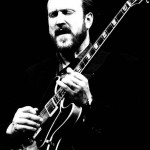 John Scofield has recorded so much and so eclectically over the last few decades that making grand claims about his sound based on the music of a single album might seem suspect. And it would be, were that sound, that musical personality, that Sco-accent, not so immediately recognizable, whether he’s playing funk, roots, fusion or bop. If I choose 1993’s What We Do as my microcosm, it is not because I think it particularly representative, or even particularly transparent. It is simply the Scofield album I know best: the first one I owned—one of the first jazz records I ever bought, in fact—and an album I have listened to with a relentlessness almost worthy of the canonical rock records of my teenage years.
John Scofield has recorded so much and so eclectically over the last few decades that making grand claims about his sound based on the music of a single album might seem suspect. And it would be, were that sound, that musical personality, that Sco-accent, not so immediately recognizable, whether he’s playing funk, roots, fusion or bop. If I choose 1993’s What We Do as my microcosm, it is not because I think it particularly representative, or even particularly transparent. It is simply the Scofield album I know best: the first one I owned—one of the first jazz records I ever bought, in fact—and an album I have listened to with a relentlessness almost worthy of the canonical rock records of my teenage years.


